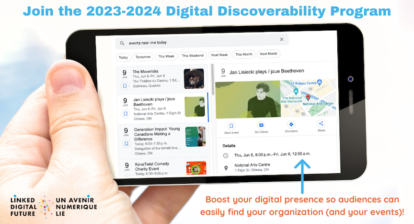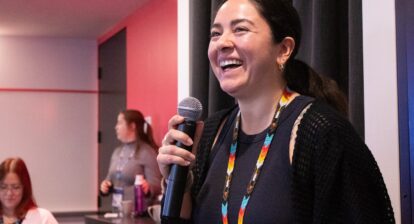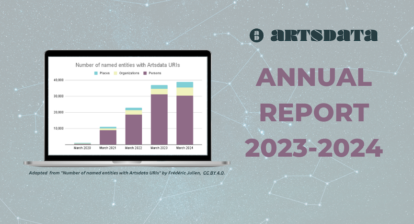By Joyce Wan
As arts organizations commit resources to taking longstanding in person festivals and events online, uncertainty continues to cloud their future. Are online performances a temporary solution to a temporary situation imposed by COVID-19 – or will the changes in the way we create and consume art in this era reshape the performing arts sector? CAPACOA hosted a two-part webinar on online performances to explore these questions, sharing research data and potential business models, including case studies from organizations that have delivered successful online events.
Fluctuations in supply and demand
The first part of the webinar, titled, “A Short-lived Substitution Activity or a New Business Model for the Performing Arts?” was held on January 19th, and the second, “Providing value for the buck (and making a few bucks in return)” on January 26th. Attendance at the webinars broke previous records (258 participants in total), indicating a surge of interest in the future of online events for the performing arts sector.
A major question facing the sector is whether the demand for online events will remain even after venues and in person events reopen. The webinar provided a few answers from consumer surveys. Research from Alberta indicated that 47% of Albertans who watched live events/performances virtually in May 2020 will consider continuing post-isolation. In the UK, 36% of culture consumers reported a firm interest in continuing to engage with online performances after the pandemic, which is lower than the 60% who engaged during the pandemic, but considerably higher than the 25% who had watched online performance prior to the pandemic. Although returning to in-person live events holds the greatest appeal, audience retention rates for virtual events could be as high as 50%.
What’s the value of an online performance?
If demand persists, monetizing online events presents another challenge. In the early months of the pandemic, many culture consumers hadn’t made up their minds about whether they would pay for online content. However, the willingness to pay for virtual events appears to have increased, possibly as a result of arts organizations trying out creative pricing strategies.
But willingness to pay isn’t universal across different forms of content; it ranks higher for “digital first” events created specifically for an online platform and for live events, in comparison to pre-recorded events. The perceived value of online events depends on many of the same elements that have always created value–quality expectations, differentiation from other offerings, and responding to a need–and these factors must be taken into consideration when creating online performances. Revenue models are still shaky, with grants and sponsorships stretching to cover the gaps left by decreased ticket revenues. Successful paid online events must deliver an experience that audience members think is worth the price.
Possible paths forward
The webinars presented case studies of a few organizations that have pivoted to virtual performances. Guillaume Déziel presented on Boucane en direct, a platform that offers bundles of shows at a discounted price; Krista Vincent at the Tuckamore Chamber Music Festival presented alongside Linked Digital Future coach Annelise Larson; Jerry Wisdom of the Windsor Symphony Orchestra presented on their live streamed events; Nathalie Courville and the Montreux Comedy Festival; and Jonathan Bunce of Wavelength Music with Linked Digital Future coach Jai Djwa on curating performances with multiple artists.
Some common themes emerged from the five case studies. Krista and Guillaume both highlighted the importance of understanding and supporting your audience’s level of digital literacy. The software you use is only as good as your users’ understanding of how to make it work. Taking time to train staff, and being prepared to assist audience members as they learn how to navigate virtual event environments, is key to a successful online event.
As arts organizations move into a space of competing more directly with big budget streaming platforms, keeping production value high is another imperative. In particular, Jerry and Jonathan both stressed that sound quality is essential. Audiences won’t tolerate bad sound quality. Jerry shared equipment recommendations in his presentation, including details on how the different pieces of equipment work together.
Discoverability was brought up frequently. A common misconception among both organizers and consumers is that putting events online makes them more easily found, thanks to the power of search engines. But there is an endless overabundance of content online, and events require structured data (which can be added with event and Schema plugins) and strong SEO to be found in the noise. The adage “if you build it, they will come” doesn’t otherwise apply. A steady presence on social media platforms is important as well. Since only a certain percentage of people are willing to pay for online events, you need to reach a large audience on these platforms in order to see a profit in ticket revenues.
Though demand for online events is predicted to decrease post-pandemic, some organizations may find success with them as a lasting business model. Online events are currently dependent on temporary subsidies, however, and we will need new business models going forward as these come to an end. It’s crucial to collect and analyze data on your audiences now, to understand their preferences and inform future strategies. Jai predicted that events are likely to go “hybrid” in the future, with virtual elements providing greater accessibility and the potential to reach a larger audience, while the irreplaceable qualities of in person events continue to draw fans. As Jonny said, there are learnings and upsides from this time that are certainly worth holding onto.
The slides and recordings from the webinars are available here:
Part 1 – recording | slides in French | slides in English
Part 2 – recording | slides in French | slides in English








